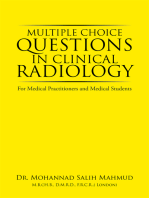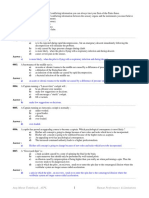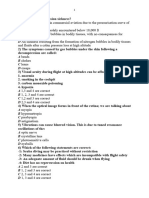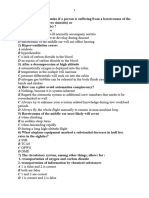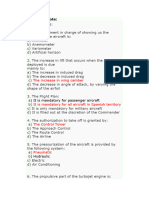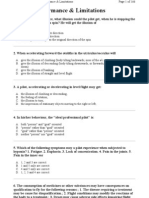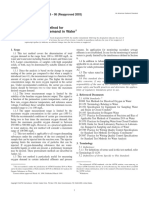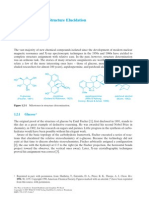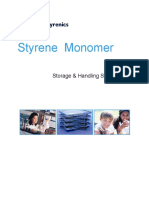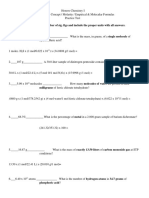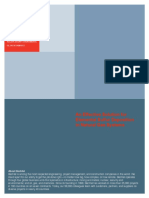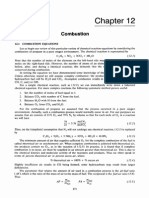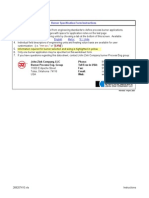HPL
Uploaded by
DinisHPL
Uploaded by
Dinis1.
Competency, according ICAO Annex 1, is based on:
a. combination of skills, knowledge and attitudes required to perform a task to
the prescribed standard.
b. combination of skills, knowledge and resources to perform a task to the
prescribed standard.
c. combination of skills and resource required to perform a task to the
prescribed standard.
d. combination of skills and knowledge required to perform a task to the
prescribed standard.
2. A pilot is skilled when he/she:1, trains or practices regularly. 2, knows how to
manage himself/herself. 3, possesses all the knowledge associated with his
aircraft. 4, knows how to keep resources in reserve for coping with the
unexpected.
a 1, 2
b. 2, 3, 4
c. 1, 2, 3
d. 1, 2, 3, 4
3. In the initial phase of flight training the relationship between confidence and
expertise can be described as:
a. The pilot is sufficiently competent to fly and knows at this stage what he can
and cannot do.
b. The pilot is competent enough to fly the aircraft at this stage, but does
neither have a great deal of confidence in his/her abilities nor in the whole
system.
c. The pilot has a sphere of expertise which is reduced to daily use of his skills.
d. During this learning stage, the pilot is very near to achieving full potential
knowledge of the machine.
4. Who in the Aviation Industry is responsible for flight safety?
a. Aircrew and Groundcrew.
b. Management, Aircrew, Groundcrew and ATC personnel.
c. Aircrew.
d. Everyone involved.
5. The circulatory system, among other things, allows for: 1, transportation of
oxygen and carbon dioxide. 2, transportation of information by chemical
substances
a. 1 is correct and 2 is false.
b. both are false.
c. 1 and 2 are correct.
d. 1 is false and 2 is correct.
6. Which of the following symptoms can indicate hypoxia? 1, Blue lips and finger
nails. 2, Euphoria. 3, Flatulence. 4, Unconsciousness.
a. 1, 2, 4
b. 1, 2, 3
c. 1, 3, 4
d. 2, 3, 4
7. At rest the cardiac output (the quantity of blood the heart pumps in one
minute) of an adult is approximately:
a. 45 liters/min
b. 75 liters/min
c. 450 ml/min
d. 5 liters/min
8. Symptoms caused by gas bubbles in the lungs, following a decompression are
called:
a. chokes
b. bends
c. creeps
d. leans
9. Positive G will cause the blood flow to the brain to:
a. remains constant.
b. first increase, then decrease.
c. decrease.
d. increase.
10. In the event of rapid decompression the first action for the flight deck crew is:
a. carry out check for structural damage.
b. don oxygen masks and ensure oxygen flow.
c. descent to the higher of 10 000 ft or MSA.
d. transmit mayday call.
11. What could cause hyperventilation?
a. Fatigue.
b. Extreme low rate of breathing.
c. Abuse of alcohol.
d. Fear, anxiety and distress.
12. One of the most dangerous symptoms of hypoxia concerning flight safety is:
a. cyanosis, reducing then pilot's ability to hear.
b. hyperventilation, causing emotional stress.
c. impaired judgment.
d. reduced coordination of limb movements, causing the pilot to spin.
13. Carbon monoxide, a product of incomplete combustion, is toxic because:
a. it competes with oxygen in its union with haemoglobin.
b. it disturbs gaseous diffusion at the alveoli capillary membrane.
c. it prevents the excretion of catabolites in the kidneys.
d. it prevents the absorption of food from the digestive tract.
14. Below 70 000 ft, what gas makes up the major part of the atmosphere?
a. Ozone
b. Oxygen
c. Nitrogen
d. Carbon dioxide
15. Grey out can be observed if a pilot is subjected to more than:
a. -3 Gz
b. +3 Gx
c. +3 Gy
d. +3 Gz
16. The total gas volume of the lung is the sum of: 1, tidal volume. 2, inspiratory
reserve volume. 3, expiratory reserve volume. 4, residual volume.
Which of the following lists the correct answers?
a. 1, 2, 3
b. 1, 2, 3, 4
c. 1, 2
d. 2, 3
17. Breathing 100% oxygen at 40 000 ft is equivalent to breathing ambient air at:
a. 18 000 ft
b. 10 000 ft
c. 8 000 ft
d. 14 000 ft
18. After a rapid decompression at approximately 35 000 ft the TUC (Time of
Useful Consciousness) will be approximately:
a. 30 - 60 seconds.
b. 3 - 4 minutes.
c. 5 minutes.
d. 15 seconds or less.
19. With regard to decompression sickness associated with flight, we know that:
a. physical activity after decompression reduces the risks of decompression
sickness symptoms to appear:
b. scuba diving does not pose any problem for a subsequent flight.
c. sex is the prime risk factor, with two out of every three women being
sensitive to it.
d. age, obesity and scuba diving are risk factors.
20. Which of the following factors may have an influence on medical
disqualification?
a. High and low blood pressure as well as a poor condition of the circulatory
system.
b. Low blood pressure only.
c. High blood pressure only.
d. Blood pressure problems cannot occur in aircrew because they can always
be treated by in-flight medication.
21. The pressoreceptors are located in:
a. the lungs.
b. the carotid and aortic arterial vessels.
c. the intestines.
d. the heart.
22. Which of the following can be a cause of anaemic hypoxia?
a. High altitude
b. Fatigue
c. Decompression
d. Smoking
23. What factors can lead to a deterioration in vision? 1, Hypoxia. 2, Smoking. 3,
Poor diet, lacking vitamin A. 4, Exposure to bright light.
Which of the following lists all the correct statements?
a. 2, 3
b. 1, 3
c. 1, 2, 3, 4
d. 1, 3, 4
24. The retina allows for the acquisition of colours as a result of the:
a. rods located in its central part.
b. cones located in its central part.
c. crystalline lens.
d. rods located in its peripheral zone.
25. What is the correct action to counteract vertigo?
a. Reduce rate of breathing until all symptoms disappear, then breathe again
normally.
b. Believe the instruments.
c. Concentrate on the vertical speed indicator.
d. Rely on the information from the semicircular canals, since these will be
transmitting correct information.
26. Empty field myopia is caused by:
a. ozone at altitude.
b. atmospheric perspective.
c. flying over mountainous terrain.
d. lack of distant focal points.
27. Which part of the vestibular apparatus is responsible for the impression of
angular acceleration?
a. The fasticular tube.
b. The tactuskin and vehicular.
c. The tetriultruslar canal.
d. The corditea.
28. A "Graveyard spin" is:
a. a spin in which the pilot, on recovery, tends to re-enter the spin due to the
somatozyral illusion where the vestibular system no longer senses radial
acceleration.
b. an illusion caused by misperception of being higher than you really are
when performing a spin. Thus the recovery tends to be dangerously low.
c. a fatal accident caused by a state of spinning the fluid in the brain.
d. a spin manoeuvre that should only be performed by well trained pilots.
29. The cocktail party effect is:
a. the tendency not to perceive relevant information.
b. the ability to drink too much at social gathering.
c. the tendency to believe information that reinforces our mental model of the
world.
d. the ability to pick up relevant information unintentionally.
30. Raising the perceptual threshold of a sensory organ means:
a. a lesser selectivity.
b. a lesser sensitivity.
c. a greater sensitivity.
d. a greater selectivity.
31. Information stays in the short-term memory:
a. less than 1 second.
b. from 5 to 10 minutes.
c. about 20 seconds.
d. around 24 hours.
32. What are two types of attention?
a. Intuitive and behavioural.
b. Divided and behavioural.
c. Cognitive and intuitive.
d. Selective and divided.
33. How can the process of learning be enhanced?
a. By reinforcing successful performance.
b. By reinforcing errors.
c. By punishing the learner for unsuccessful trials.
d. By increasing the psychological pressure on the student.
34. Motor programs are:
a. stored routines that enable patterns of behaviour to be executed only under
continuous conditions control.
b. rules that enable us to deal with novel situations.
c. stored routines that enable patterns of behaviour to be executed without
continuous conditions control.
d. rules that enable us to deal with preconceived situations.
35. Perception is based upon:
a. information received as well as past experience and knowledge.
b. past experience and knowledge only.
c. information received only.
d. solely upon technical ability.
36. What are the main consequences of latent errors? They: 1, remain undetected
in the system for a certain length of time. 2, may only manifest themselves
under certain conditions. 3, are quickly detectable by the front-line operator
whose mental schemas on the instantaneous situation filter out formal errors.
4, lull the pilots into security.
The correct statement(s) is (are):
a. 1, 2, 4
b. 2, 3, 4
c. 1, 2
d. 1, 3
37. Human errors are frequent and may take several forms:
a. A violation is an error which is always involuntary.
b. An error can be described as the mismatch between the pilot's intention
and the result of his/her actions.
c. Representational errors in which the pilot has properly identified the
situation and is familiar with the procedure.
d. An error of intention is an error of routine.
38. The expression "when perception matches reality" describes:
a. attention
b. vigilance
c. alertness
d. situational awareness
39. According to the classification of errors by James Reason, which different
types of errors can a pilot commit?
a. Active and latent errors
b. Threats, errors, undesired aircraft states (UAS)
c. Isolated errors, error chains
d. Faults, slips, omissions and violations
40. Habits and routine can influence decision-making in a way that:
a. one always wants to see previous experience confirmed by new decisions.
b. a tendency to select the most familiar solution first and foremost,
sometimes to the detriment of achieving the best possible result.
c. one always selects a choice in accordance with the company's usual
practices.
d. professional pilots will never question established procedures.
41. Group norms:
a. regulate the interaction and the behaviour between the members of a
group.
b. have no influence on the working behaviour of the group.
c. are always fixed in a written way and can be looked up.
d. diminish the morale of the group.
42. The behaviour of a leader depends on:
a. the authority gradient only.
b. his/her ability to prevent discussions among the crew members in order to
avoid conflict.
c. only his/her ability to dominate and be assertive.
d. the situation, the goals and composition of the group.
43. Having interrupted the captain for a sound reason, the co-pilot should:
a. ensure there is no ATC traffic on the radio that may be causing a possible
distraction before continuing.
b. never interrupt his/her captain at a critical stage of flight.
c. remind him/her of his/her last action before the interruption.
d. never interrupt his/her captain at a critical stage of flight.
44. Coaction is a mode of coordination which recommends:
a. working parallel to achieve one common objective.
b. the application of procedural knowledge in the conduct of specific actions.
c. working parallel to achieve individual objectives.
d. sustained cooperation on actions and the formulation of commitments
concerning flight situations.
45. The use of checklists must be carried out in such a way that:
a. their execution is not lumped together with important tasks.
b. their execution must not be done simultaneously with other actions.
c. it may be rejected since redundancy in the following checklist will serve as
verification.
d. their execution may be done simultaneously with other actions.
46. Which of the following describes an autocratic cockpit?
a. The atmosphere is relaxed thanks to a captain who leaves complete
freedom to the various members of the crew.
b. The captain's excessive authority considerably reduces communications and
consequently the synergy and cohesion of the crew.
c. Each of the members chooses what job to do without telling the others and
in the belief that everyone is aware of what he is doing.
d. Despite the overly strong authority of the captain, everything functions
correctly owing to his natural leadership.
47. The level of automation helps to conserve resources. On the other hand, it
may result in:
a. decision-making errors.
b. errors in selecting an appropriate plan of action.
c. routine errors (slips).
d. behavioural errors.
48. What is "automation complacency"?
a. The circumstance where monitoring and cross-checking is reduced because
of the belief in the infallibility of the automatic systems.
b. Automation is now so reliable that the human input is no longer necessary.
c. The circumstance where the pilot flies the aircraft manually because he is
unable to rely on the automatic systems flying the aircraft safely.
d. No over-ride facility is available on auto-flight selection as there are enough
levels of redundancy to cope with any system failure.
You might also like
- Multiple Choice Questions in Clinical Radiology: For Medical Practitioners and Medical StudentsFrom EverandMultiple Choice Questions in Clinical Radiology: For Medical Practitioners and Medical Students5/5 (1)
- 050 Human Performance - Limitations (906 Soru)No ratings yet050 Human Performance - Limitations (906 Soru)131 pages
- Podstawy Projektowania Architektonicznego - ZadanieNo ratings yetPodstawy Projektowania Architektonicznego - Zadanie164 pages
- Final - Oxford Speci Human Performance 1No ratings yetFinal - Oxford Speci Human Performance 198 pages
- 040 Human Performance & Limitations - V2+v3 - 31OUT09100% (1)040 Human Performance & Limitations - V2+v3 - 31OUT09166 pages
- Comprehensive Ophthalmology Multiple-Choice Questions and Answers Study GuideFrom EverandComprehensive Ophthalmology Multiple-Choice Questions and Answers Study GuideNo ratings yet
- Cambridge International As and A Level Chemistry100% (9)Cambridge International As and A Level Chemistry557 pages
- 2003 - D.graiver - A Review of The Fate and Effects of Silicones in The EnvironmentNo ratings yet2003 - D.graiver - A Review of The Fate and Effects of Silicones in The Environment8 pages
- Filtration and Reuse of Water in Fish Farming 1200dpiNo ratings yetFiltration and Reuse of Water in Fish Farming 1200dpi39 pages
- Documents - MX - Absorption Exercises Treybal PDF100% (1)Documents - MX - Absorption Exercises Treybal PDF6 pages
- Water Quality and Water Quality Management in Aquaculture100% (1)Water Quality and Water Quality Management in Aquaculture20 pages
- 2024 Jce - Chemistry Chief Examiner's ReportNo ratings yet2024 Jce - Chemistry Chief Examiner's Report11 pages
- Marine Science for Cambridge International AS A Level Coursebook 2nd Edition Matthew Parkin - Quickly download the ebook to explore the full content100% (2)Marine Science for Cambridge International AS A Level Coursebook 2nd Edition Matthew Parkin - Quickly download the ebook to explore the full content63 pages
- Styrene Monomer: Storage & Handling Safety GuideNo ratings yetStyrene Monomer: Storage & Handling Safety Guide17 pages
- Solid & Liquid Fuels:: Combustion CalculationsNo ratings yetSolid & Liquid Fuels:: Combustion Calculations6 pages
- 2006 - Bykovskii - JPP22 (6) Continuous Spin DetonationsNo ratings yet2006 - Bykovskii - JPP22 (6) Continuous Spin Detonations13 pages
- An Effective Solution For Elemental Sulfur Deposition in Natural Gas SystemsNo ratings yetAn Effective Solution For Elemental Sulfur Deposition in Natural Gas Systems12 pages
- MM W.C.: Burner Specification Form InstructionsNo ratings yetMM W.C.: Burner Specification Form Instructions10 pages
